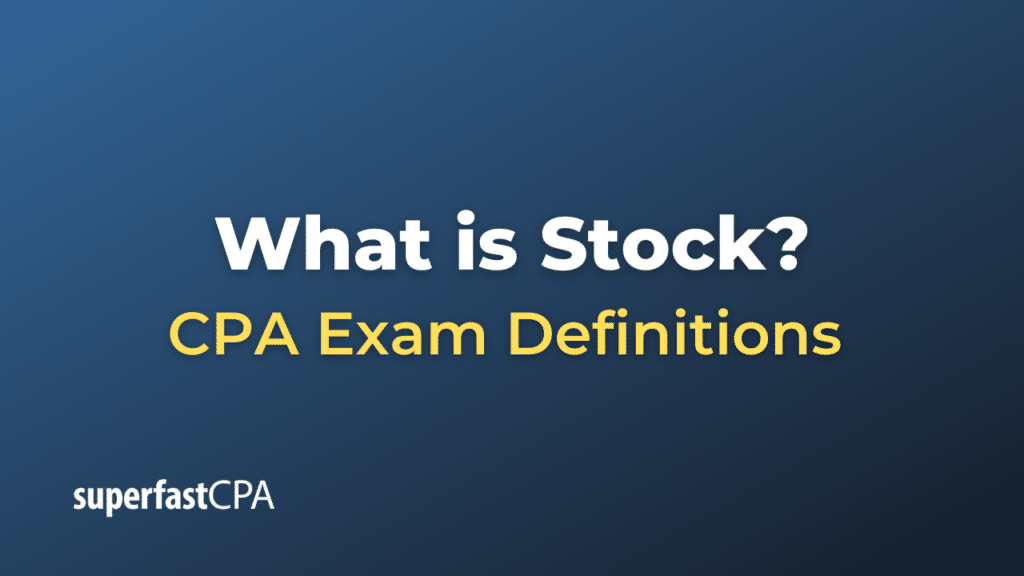Stock
In accounting, the term “stock” primarily refers to ownership shares in a corporation. However, there are a few contexts where the term might be used, and its meaning can differ based on that context:
- Equity (Ownership Shares in a Corporation):
- This represents ownership in a company. If a company has issued stock, it means they have sold a portion of the company to raise capital. The two main types of stock are:
- Common Stock: Represents basic ownership in a corporation, giving the holder voting rights and a share of profits (dividends).
- Preferred Stock: Represents a higher claim on assets and earnings than common stock. Holders of preferred stock get dividends before common stockholders and have a higher claim on assets if the company is liquidated. However, preferred stockholders typically don’t have voting rights.
- In the balance sheet, these are shown under the shareholders’ equity section.
- This represents ownership in a company. If a company has issued stock, it means they have sold a portion of the company to raise capital. The two main types of stock are:
- Inventory:
- For businesses that deal with tangible products, “stock” can also refer to the goods on hand available for sale or the raw materials used to produce finished products. This is the company’s inventory.
- On the balance sheet, inventory is an asset, typically listed under current assets.
- Treasury Stock:
- This refers to shares that were once part of the outstanding shares of a company but were repurchased by the company. These shares don’t have voting rights, don’t pay dividends, and are not included in earnings per share calculations.
- On the a, treasury stock is usually listed as a contra equity account, which means it’s subtracted from total shareholders’ equity.
- Stock Dividends:
- Stock Account:
- In some systems of accounting, especially outside the U.S., the term “stock” is used synonymously with “inventory.” Thus, a “stock account” would be an account tracking the value of goods available for sale.
In accounting, understanding the context in which “stock” is mentioned is essential, as its meaning can vary. Typically, financial statement notes and additional disclosures will provide clarity on how the term is being used in any given report.
Example of Stock
Let’s delve into an example of “stock” in the context of accounting, focusing on a hypothetical company named “GreenTech Innovations.”
GreenTech Innovations: Accounting Treatment of Stock
- Equity (Ownership Shares):
- GreenTech Innovations issues 1,000,000 shares of common stock at $10 per share, raising $10,000,000 in capital.
- On the balance sheet:
- Shareholders’ Equity Section:
- Common Stock: $10,000,000
- Shareholders’ Equity Section:
- Inventory:
- GreenTech Innovations manufactures eco-friendly electronic gadgets. At the end of the year, it has $2,500,000 worth of gadgets in its warehouse ready to be sold.
- On the balance sheet:
- Current Assets Section:
- Inventory: $2,500,000
- Current Assets Section:
- Treasury Stock:
- Later, GreenTech decides to repurchase 50,000 of its shares from the open market at $12 per share, costing the company $600,000.
- On the balance sheet:
- Shareholders’ Equity Section (as a deduction):
- Treasury Stock: $600,000
- Shareholders’ Equity Section (as a deduction):
- Stock Dividends:
- GreenTech decides to issue a 5% stock dividend to its shareholders. This means that for every 100 shares a shareholder owns, they receive an additional 5 shares.
- Assuming no other changes in the number of shares, this results in the issuance of an additional 50,000 shares (5% of 1,000,000 shares).
- This doesn’t change the total equity but redistributes it among a larger number of shares.
- Stock Account (Inventory in some systems):
- Imagine GreenTech Innovations operates in a region where the term “stock” is used synonymously with “inventory.” At the end of the fiscal year, their accounting records show:
- Stock Account (representing inventory): $2,500,000
- This means GreenTech has $2,500,000 worth of products ready for sale.
- Imagine GreenTech Innovations operates in a region where the term “stock” is used synonymously with “inventory.” At the end of the fiscal year, their accounting records show:
This example illustrates how “stock” can be represented in various ways on a company’s financial statements. Each treatment has different implications for the company’s financial health, performance, and valuation.














